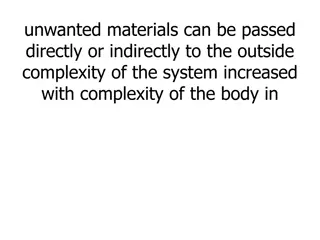Mycoplasma: Structure, Reproduction, and Characteristics
Detailed exploration of Mycoplasma covering its structure, reproduction, and general characteristics. Discusses the ultrastructure, species like Mycoplasma pneumonia and Mycoplasma hominis, and their unique traits such as lack of cell wall, pleomorphism, and reproduction methods. The article also touches on Mycoplasma's significance in cattle disease and plant infections.
Download Presentation

Please find below an Image/Link to download the presentation.
The content on the website is provided AS IS for your information and personal use only. It may not be sold, licensed, or shared on other websites without obtaining consent from the author.If you encounter any issues during the download, it is possible that the publisher has removed the file from their server.
You are allowed to download the files provided on this website for personal or commercial use, subject to the condition that they are used lawfully. All files are the property of their respective owners.
The content on the website is provided AS IS for your information and personal use only. It may not be sold, licensed, or shared on other websites without obtaining consent from the author.
E N D
Presentation Transcript
STRUCTURE AND REPRODUCTION OF MYCOPLASMA Dr. N.Reehana Asst. Prof Asst. Prof- - Microbiology Microbiology PG & Research Dept. of Microbiology PG & Research Dept. of Microbiology Jamal Mohamed College (Autonomous) Jamal Mohamed College (Autonomous) Tiruchirappalli Tiruchirappalli 620 020 620 020
CONTENTS Introduction General characteristics Ultrastructure of mycoplasma Mycoplasma pneumonia Mycoplasma hominis Mycoplasma genitalium Reproduction inmycoplasma
INTRODUCTION Mycoplasma is commonly known as pleuropnemonia First organism to be recognised as responsible for highly contagious disease of cattle pleuropnemonia known as bovine Doi et al.(1967) Ishiie et al.(1967) reported mycoplasma to be the causitive agents of many plant diseases such as Aster yellows, Potato witches broom and Dwarf disease of mulberry Mycoplasma refers to a genus of bacteria that lack a cell wall. Without a cell wall, they are unaffected by many common antibiotics such as penicillin or other beta-lactam antibiotics that target cell wall synthesis. They can be parasitic or saprotrophic.
General characteristics Lack a rigid cell wall Extremely pleomorphic Surrounded by a single triple layered membrane containing cholesterol
Smallest free living organisms Gram ve, but better stained with Giemsa stain Non-sporing, non-flagellated Non-motile, may show gliding motility Reproduce by fission & budding Spherical (125-250nm) Branching filaments (500-1000nm) Killed by heating at 56 C X 30 mnts Lysis by surface active agents & lipolytic agents Cannot synthesize cholesterol Need incorporation of sterol in medium Resistant to cell wall active antibiotics Contain both RNA & DNA Can reproduce in cell free medium Ureaplasma hydrolyze urea
ULTRASTRUCTURE OF MYCOPLASMA Cells are very small measuring 0.2- 0.3 micrometer in diameter Cells occur in coccus, elongated and filamentous form Cells are nonmotile and lack cell wall Cell comprises of 3 components cell membrane, ribosomes, and nucleoid i.e. highly coiled circular chromosome Cell membrane section shows triple layered 75A to 110A thick structure Cell membrane have higher lipid content than bacteria
Protein constitutes 50-80% of the dry weight of whole cell DNA is 4-7% and RNA is8-17% Remarkable property is to squeezing through filter pores smaller than their actual diameter Most of the species on solid media form characteristic small fried egg colonies Denser inclusions sometimes limited by triple layered membranes, as well as surrounded vesicles, were observed in the cytoplasm of cells of some strains Cells show close similarity of internal structure to that of bacteria except there is a triple layered external membrane in place of cellwall
Mycoplasma pneumonia M pneumoniae is one of the smallest free- living organism capable of self replication They lack peptidoglycon cell wall They are resistant to penicillin and beta lacton antibiotics They have cell membrane with sterol compounds Mycoplasma pneumonia, an airborn bacterium, causes upper respiratory tract infections which lead to mycoplasma pneumonia in 5 to 10 percent of patients. It can also lead to tracheobronchitis, according to the Centers for Disease Control and Prevention.
Mycoplasmahominis They lives parasitically and saprophytically They are pleuromorphic, gram negative, diameter 0.2-0.3 micrometer Their shape varies from coccoid, filamentos,irregular These include ribosome like granules, irregular dark region & mesh like strands in nuclear region. Mycoplasma hominis, a small pathogenic bacterium lacking a cell wall, is the only type of mycoplasma in which the genome sequence is unknown. It causes genital infections in women and causes extragenital infections in newborns, especially ones with immuno-deficiencies, according to Genoscope.
Mycoplasma genitalium They are small parasitic bacterium M. genitalium is flask shaped and do not have a cell wall like all mycoplasma species Lacking a cell wall they have only a plasma membrane, with over two thirds of its mass containing proteins. M. genitalium is so far one out fifteen mycoplasma species of human origin They live on ciliated epithelial cells of the primate genital & respiratory tracts M. genitalium is a motile mycoplasma. It uses a specialized tip structure to attach to surfaces and glide across them. It generally causes no symptoms in those affected, is a sexually transmitted disease similar to gonnorrhoea and chlamydia, according to Women's Health. It causes bacterial vaginosis in women and urethritis in men. Antibiotics can treat the bacteria.
Reproduction inMycoplasma Mycoplasma undergoes binary fission , a common form of replication in prokaryotes including many bacteria, to create new offsrings. Binary fission a method of asexual reproduction that involves splitting of a parent cell into two approximately equal parts. This process is slow in mycoplasma and it is not uncommon for the cell to have more than one set of genetic information.
The cell elongation takes place and genetic material DNA isreplicated. Soon thereafter one copy of the origin begins to move towardsthe other end of the cell. After the finishing of replication, the cell membrane begins togrow inward between the two DNAmolecules. As soon as the formation of septum is completed the cellsgets separated. Binary fission in Mycoplasma bovis
CONCLUSION : Mycoplasma refers to the genus of bacteria that lack cell wall and these are considered to be the smallest free living organisms capable of self replication. Further knowledge about mycoplasma - ultrastructure, cell membrane, genome and metabolic pathways resulted in conclusion that they are smallest and simplest self replicating organisms. There cell structure is very simple and reproduces binary fission. by
THANK THANK YOU YOU























